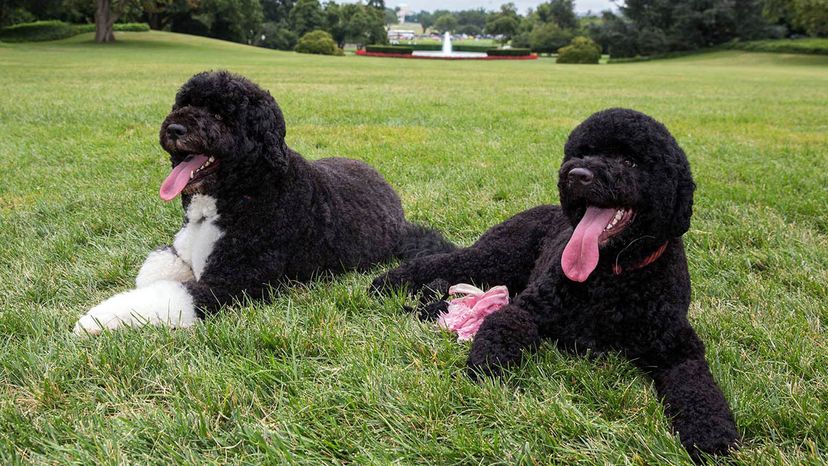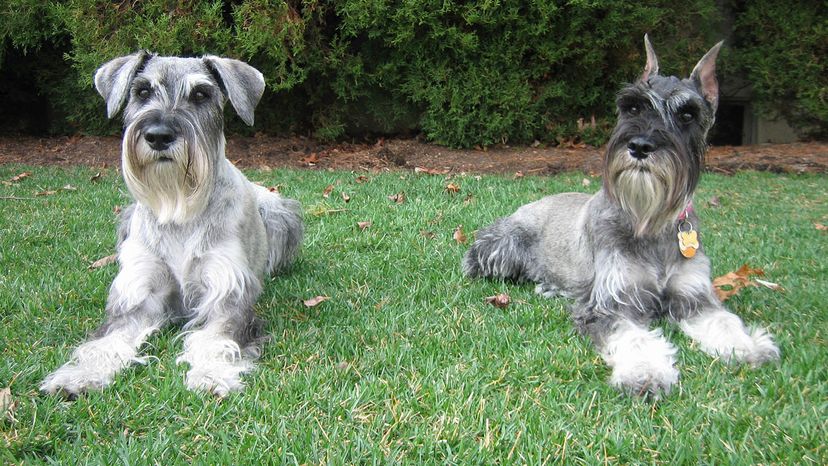 “(L-r) Former first dogs Bo and Sunny Obama are Portuguese Water Dogs. The Obamas chose the Portuguese Water Dog breed because Malia Obama has allergies and needed a hypoallergenic breed. Pete Souza/Public Domain
“(L-r) Former first dogs Bo and Sunny Obama are Portuguese Water Dogs. The Obamas chose the Portuguese Water Dog breed because Malia Obama has allergies and needed a hypoallergenic breed. Pete Souza/Public Domain
With the appeal of all cuddles and no allergic reactions, hypoallergenic dogs seem like the obvious choice for animal lovers who are all too sensitive to those wet noses and wagging tails. But are these hypoallergenic dogs too good to be true?
The truth is, these specific breeds of pups touted as hypoallergenic don’t shed fur, and because of this trait, many breeders promise these dogs won’t trigger any allergies at all. Except, they can.
Why Are People Allergic to Dogs?
So what gives? According to the Mayo Clinic, it’s not actually a dog’s fur that’s responsible for a human’s allergic reactions; it’s what’s stuck on the fur that causes our sneezing or asthma attacks. People who are allergic to dogs are triggered by the protein in a dog’s saliva and urine that sticks to the dander (dried flakes) on a dog’s skin. When a dog sheds its fur (and dander), that allergy-inducing protein is released into the air. That’s why non-shedding breeds tend to lessen allergic reactions in humans — no shedding means fewer of those allergen-inducing proteins are released. But no dog breed is entirely hypoallergenic.
"There is no such thing as a truly hypoallergenic dog," says Melanie Carver, vice president of community health for the Asthma and Allergy Foundation of America. "There are some breeds of dogs that shed less hair and are marketed as ‘hypoallergenic,’ but this is just a marketing term and not a medical term."
Which Dogs Are Best for People With Allergies?
So while "hypoallergenic" may be a fluff term, having a non-shedding breed is totally helpful for people that have allergies and want a dog, too. The American Kennel Club reports that many "less-allergenic breeds" do produce less dander.
This, paired with the fact these dogs don’t shed, makes several pure-bred and mixed breeds the perfect fit for people prone to allergies:
- Afghan hounds
- Bichon Frises
- Irish Water Spaniels
- Maltese
- Poodles
- Portuguese Water Dogs
- Schnauzers
- Bichon-Poodles
- Maltese-Poodles
 “Standard Schnauzers are also known to be good options for anyone wanting a dog that doesn’t shed much.Wikimedia
“Standard Schnauzers are also known to be good options for anyone wanting a dog that doesn’t shed much.Wikimedia
There’s No One-size-fits-all Solution
Labrador retrievers, however, can "wreak havoc on your allergies," according to the AKC. That said, it’s not a one-size-fits-all solution.
"Some people with a dog dander allergy may be less reactive or have less symptoms to dander from certain breeds," Carver says. "Allergy testing cannot determine which breeds may work better for you than others. The only way to determine if you can tolerate being around a certain breed is to have direct, repeated exposure to a dog and see how your body reacts."
While the typical signs of pet allergies may seem obvious — sneezing, scratchy throat or itchy eyes — several lesser-known symptoms can also appear, according to the Mayo Clinic. If you’re doing a test run with a pup, keep an eye out for facial pressure and pain, swollen blue-tinted skin beneath your eyes, and excessive coughing. These symptoms are similar to allergies caused by hay fever; they’re caused by the inflammation of nasal passages.
Other allergic reactions can affect the skin, resulting in hives, eczema and itchiness. In the most serious cases, pet allergies can also contribute to asthmatic reactions like chest tightness, wheezing, difficulty breathing and trouble sleeping.
Many pet allergy warning signs resemble symptoms of a regular cold. The Mayo Clinic notes symptoms that last beyond two weeks are likely allergies, and therefore a red flag.
Curbing Allergies With a New Pup
In some severe cases, it’s impossible to find a dog that doesn’t trigger allergies. But, more often than not, a few trials can lead to the perfect pup. Breed plays the biggest role, but several other factors — such as dog size — can help or hurt allergy-prone owners. Big dogs produce more dander and saliva, for instance. And small dogs are just easier to bathe and groom.
Frequent grooming — which is required for any non-shedding dog — is one way to stay ahead of allergies. Another recommendation is setting ground rules when it comes to lounge time. The AKC suggests keeping pets off the bed (and washing their pet beds regularly). It also recommends ditching heavy carpets and drapes that are known to trap and hold on to dander. Carver also suggests brushing and grooming your pet outside, vacuuming regularly, and washing your hands and changing clothes after playing with your pup.
It’s not all doom and gloom for those who have pet allergies. Several types of medicines can help owners further manage their allergy symptoms. Over-the-counter antihistamines help relieve itching, sneezing and runny nose, while nasal sprays like can help reduce inflammation.
Doctors may also prescribe stronger medications for patients who have both asthma and allergies. And other allergy treatment options include immunotherapy (a series of allergy shots) and nasal irrigation like a neti pot.
Now That’s Interesting
Humans aren’t the only ones who have dander allergies; dogs can be allergic to human dander, too. According to ABC News, a rescued black Lab in Indianapolis underwent immunotherapy to help his immune system tolerate humans. The outcome? A forever home with his new favorite human.





























